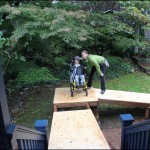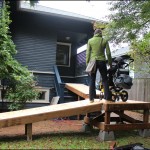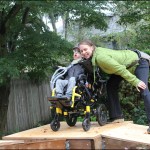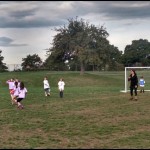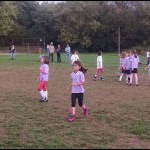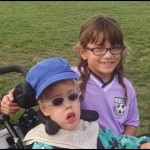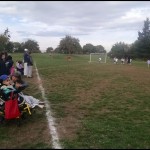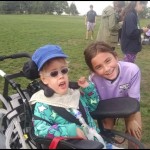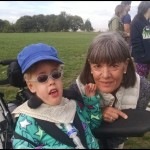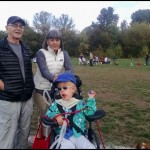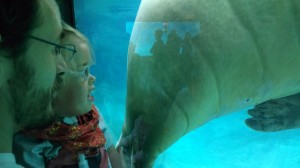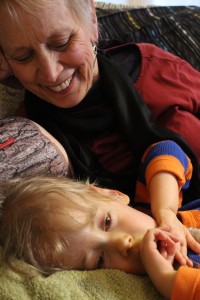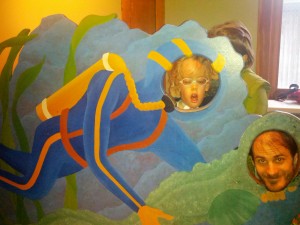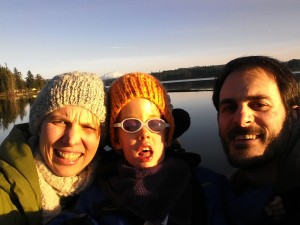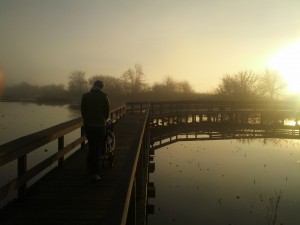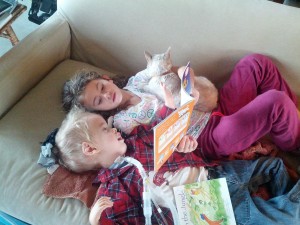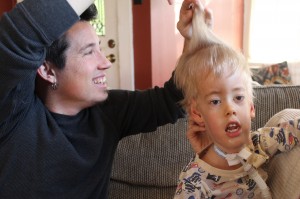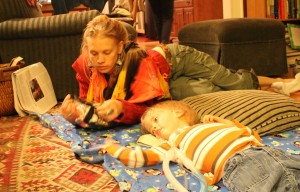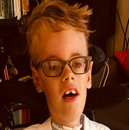Spring has brought a lot of exciting energy and adventure to our lives, and we’ve been feeling incredibly grateful for all our good health and ability to get out. Just in the past three weeks we’ve gone to the Arboretum, the zoo, the aquarium, three neighborhood libraries, Seward Park, Mother’s Day brunch with all the family… And just over Memorial Day weekend we took Lucas to Folklife, Seattle’s annual folk music festival, and then out to explore Vashon Island. We recently got an email from a family with a baby who just made it through his first winter with MTM, and they described reading about our travels like “science fiction.” And I sometimes have to pinch myself — I could never have imagined this much getting out of the house for our lives a few years ago.
There’s so much more to say about all that – including all the challenges and less than picture-perfect moments – but for now I want to tell the specific story of the city park near our home that is slated for upgrades.
There’s a beautiful, huge green park near our house, and recently a sign went up announcing plans for renovations, including increased access. When I read ADA — Americans with Disabilities Act — my heart jumped. This could mean more access FOR LUCAS to our neighborhood park and playground.
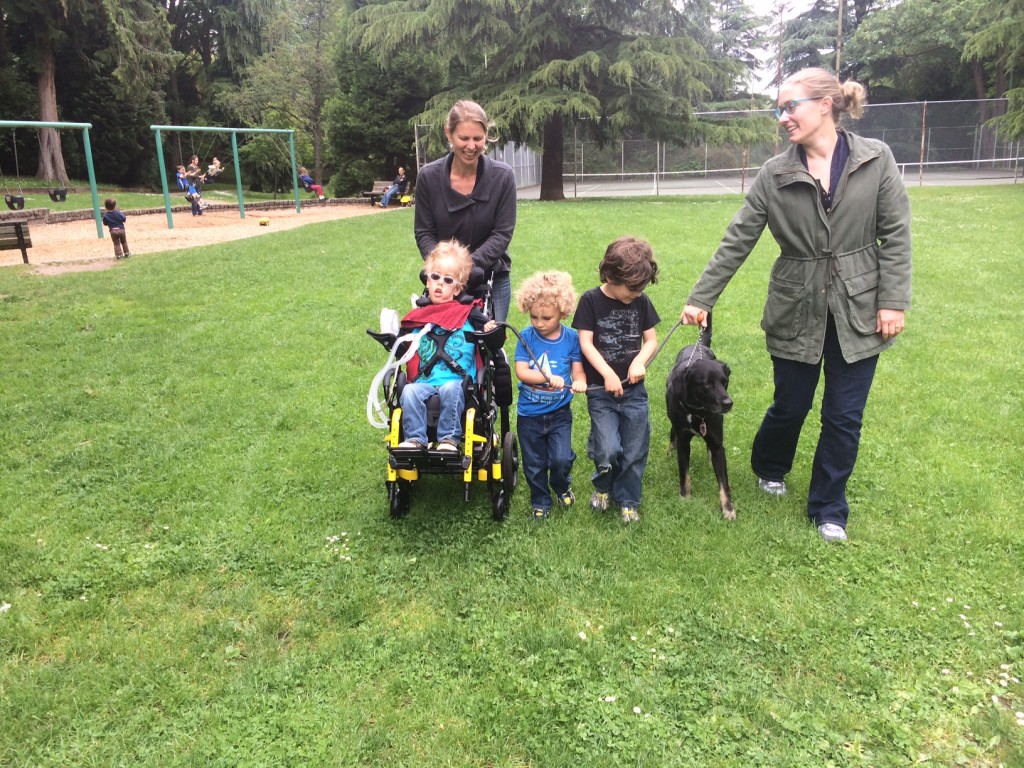 Here’s a brief description of the park from our perspective: a huge, beautiful lawn lined with giant trees. It’s a field with grass – not a super smooth lawn – so it’s bumpy and slow going for Lucas. If we get to the park and see someone on the other side of the lawn, we don’t bother trying to get over to them — they’ll likely be gone by the time we get there. But we use the lawn nonetheless. We throw blankets out and lie down and look up at the trees, the sky, and the crows. We have tried flying a kite, and we sometimes turn it into a baseball field, with Lucas stationary (“pitching”), and everyone else fielding the balls. This weekend we were there, and Lucas walked Mona, with patient help from friends Earl, Winslow, and Heidi (see picture).
Here’s a brief description of the park from our perspective: a huge, beautiful lawn lined with giant trees. It’s a field with grass – not a super smooth lawn – so it’s bumpy and slow going for Lucas. If we get to the park and see someone on the other side of the lawn, we don’t bother trying to get over to them — they’ll likely be gone by the time we get there. But we use the lawn nonetheless. We throw blankets out and lie down and look up at the trees, the sky, and the crows. We have tried flying a kite, and we sometimes turn it into a baseball field, with Lucas stationary (“pitching”), and everyone else fielding the balls. This weekend we were there, and Lucas walked Mona, with patient help from friends Earl, Winslow, and Heidi (see picture).
Along the west side of the lawn there is a zip line, play equipment, and a swing set. We only go to the play structures when we have friends with kids who want to play, but Lucas can’t get onto or even roll up to any of the equipment because of the wood chips around it all. There is one set of monkey-bars-like things that has a hard rubber surface underneath, and this is by far the best part for Lucas. If his cousins crawl up, run under, or daddy lies on top of the monkey bars, Lucas can roll up to or under or around the structure. He can at least get close enough to be part of the action for a minute. Mostly we just use the paved path that skirts the edge of the park and takes us down to the lake.
So when I saw the sign go up, super-disability-mom fantasies got the best of me. I emailed the project manager and started to research the most accessible parks in the country. I polled other MTM families and put together a list of things that would make the park better for wheel-chair users, from what I considered minor improvements (flat, rubber surfaces to wheel along) to dream-come-true ideas (a giant, 12-person swing that kids can walk or wheel onto and play together), and I brought that list to the meeting. My heart sunk when we started to talk. I realized that their vision of “accessible” meant meeting some minimum standards: a gravel-packed path from the handicapped parking space to the swings. Maybe another short path. Smaller steps on the play equipment. (“Stairs!?” you might think, like I did. I think they were conflating ADA accessibility minimums with other safety standards.) I tried to be inspiring, describing Lucas, telling them I cared about access for all park users and that I would help find other people with access needs to give input, as well. The project manager was very warm and receptive. But the main architect just kept asking me if Lucas enjoys the zip line (she asked so many times I almost barked at her), and so when I handed the team my list of ideas I was already feeling pretty deflated.
Jump ahead to the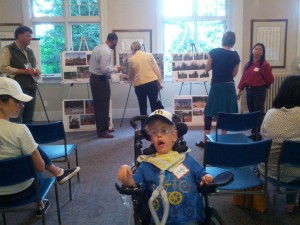 community meeting to give input on the park one week later. We decided not to rally all the pro-Lucas, pro-access troops we could, but maybe that was a mistake. As one neighbor observed in his minutes from the meeting, the sentiment in the room was “overwhelmingly conservative.” People in our neighborhood – at least the people who attended the meeting – love the park exactly as it is. There were valid concerns about changes that might not be improvements. Don’t cut down any trees; don’t sacrifice learning and adventure for too much safety; don’t bring in fancy playground toys when kids love the simple structures; don’t cover the playground in plastic. I get all that. I was doing OK.
community meeting to give input on the park one week later. We decided not to rally all the pro-Lucas, pro-access troops we could, but maybe that was a mistake. As one neighbor observed in his minutes from the meeting, the sentiment in the room was “overwhelmingly conservative.” People in our neighborhood – at least the people who attended the meeting – love the park exactly as it is. There were valid concerns about changes that might not be improvements. Don’t cut down any trees; don’t sacrifice learning and adventure for too much safety; don’t bring in fancy playground toys when kids love the simple structures; don’t cover the playground in plastic. I get all that. I was doing OK.
And then one parent spoke up asking them to stop the train on the renovations and please not change anything. He actually said “I’ve never heard any parent say they had a bad day at the park.” And then I started to tremble. Because suddenly someone was verbally erasing my experience of the park. We have awesome days in the park, but we also have days that are incredibly painful. We can see all the kids playing together, and their parents chatting along the edge of the play equipment. On days when it has rained a lot recently, I couldn’t push Lucas through the mud to reach them even if I tried. And then, what would be the point of reaching the inaccessible play equipment anyway?
There are some fabulous parents go out of their way to bring their kids over to meet Lucas, but plenty of parents don’t. I don’t mind that — we don’t need everyone coming over to see us. Sometimes we just want to be alone (as in, just me, Burke, Lucas, and a small bug in a container.) But there are days we wish so badly that Lucas could play with the other kids that it hurts.
Of course hard packed surfaces and giant gliders that pack kids onto benches next to kids in wheelchairs won’t change everything. But it will give Lucas the option of playing with kids his age at the playground. It doesn’t seem like that much to ask, especially given that the city has a pretty big budget to do it.
I tried to breath before raising my hand, but I was still quite emotional when I spoke about the fact that there are really hard days for us at the park. And that we like the idea of access. I stressed the importance of hard-packed surfaces as a key piece of Lucas’s ability to be in the play area, in part because the city architect had said to me multiple times that it would be too expensive, so we needed community back-up on this being a priority. And then I listened.
For a while no one else spoke up on behalf of access. Just “don’t try to make the zip line less fun by taking out the incline” and “keep our playground natural.” Finally one person proposed a compromise — the city should focus its funds on some access trails and not on changing play equipment. But then there was a lot more discussion of the zip line, including one neighbor contending that she and her family moved to the neighborhood just for the zip line.
For what it’s worth, I’ve been down the zip line and it is fun. And Lucas’s cousins think its pretty cool. We support keeping the zip line. But it’s hard for me to imagine what its like to come to a community meeting with a passion for the playground and, after seeing Lucas there and hearing about his needs, staying silent about access and only speaking out about love for the status quo. Or maybe not. Maybe that would have been me if my life had been different, not out of ill-will, but not knowing how to talk about disability and access. God knows I’ve learned a lot of language in the last four years. But we’re looking for allies, and I wish more of those neighbors were interested in the experiences of families other than just their own – ours and plenty of others who weren’t in the room. And of course we need to listen to the other families’ concerns. I hadn’t even thought about the fact that “safety” in the US means preventing lawsuits, so fun things like natural landscapes, or gravel to dig in, get taken away.
The heated community playground input meeting adjourned on a lighter note (the city landscape architect and project manager committed to going strait over to the zip line to experience it themselves.) And some neighbors who know us came up to me afterward and asked if there is anything they can do to help us advocate for access. And of course the answer is yes! I’m going to amend the letter I submitted to the city planner and give it out to neighbors as a list of things to write to the city to ask for. Because the reality is that at this point, even the minimum hope for hard rubber surfaces will be a big victory.
——————–
Here is the letter I submitted:
May 15, 2014
To Mr. Jeron Gates and the Seattle Parks Department,
As a neighbor in the Mt Baker neighborhood and parent of a child with disability, I am excited to help with the visioning and planning of the accessibility improvements to our park.
Over the last month I have paid attention to the way our use of the park is currently limited and asked parents in other parts of the country who have taken their children to accessible playgrounds for their input. Here are some of my initial ideas.
Accessibility additions that would improve Mt Baker Park and playground for wheelchair users:
(1) Follow principles of universal design, taking into account usability of the park by all people including right and left handed people, people with differences in sensory processing, different ways of moving, etc.
(2) Hard surfaces (like recycled rubber) under all equipment. No bark, mulch or other soft surfaces.
(3) Paved pathways from sidewalks and walkways to the play equipment.
(4) Paved pathway around the park – circling the whole upper field and with access to the stream lower down the park.
(5) Wheelchair ramps onto play structures and accessible bridges between large pieces of equipment.
(6) Sway Fun Glider – equipment that allows wheelchair users and non-disabled children to play together on the same piece of equipment.
(7) Drive-on wheelchair swing and other play equipment that incorporates wheelchair users.
(8) Shade – not specific to wheelchair users, but many people are affected by sun and rain.
Many of these improvements are specific to wheelchair users, which is my area of knowledge. However, I am interested in the park being as welcoming and inclusive as possible to all users, so I would be happy to help gather more people with other needs to help give input into the design.
A few resources I’ve found with great accessible playgrounds include:
- Locally: Project Orca Playground is a parent and community-driven project to update the Orca K-8 playground. The school has two classrooms of high-needs special ed students, so the planning is including thinking about accessibility for those students. Columbia City architects Johnson Southerland are working on the design. https://www.facebook.com/ProjectOrcaPlayground
Thank you for your work and commitment to making the park accessible to all users! Please let me know how I can continue to help.
Sincerely,
Krista Hanson
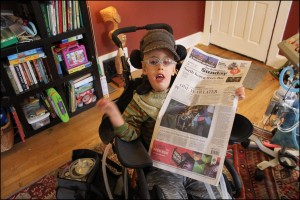 The final bit of news is that Lucas made the front page of the Sunday Seattle Times! You may recall that a little over a year ago our family was featured in the newspaper as having already benefited from the Affordable Care Act, among other stories of people in Washington state who would be affected by the implementation of the ACA. Well, the Times decided to do a “one-year-later” update, and as part of the series sent a photographer to grab some shots of Lucas. On Sunday, we got the paper and found a huge picture of Lucas coming down off the school bus lift, along with his nurse Laurel, the bus driver Mary, and me. Lucas thought it was pretty cool.
The final bit of news is that Lucas made the front page of the Sunday Seattle Times! You may recall that a little over a year ago our family was featured in the newspaper as having already benefited from the Affordable Care Act, among other stories of people in Washington state who would be affected by the implementation of the ACA. Well, the Times decided to do a “one-year-later” update, and as part of the series sent a photographer to grab some shots of Lucas. On Sunday, we got the paper and found a huge picture of Lucas coming down off the school bus lift, along with his nurse Laurel, the bus driver Mary, and me. Lucas thought it was pretty cool.